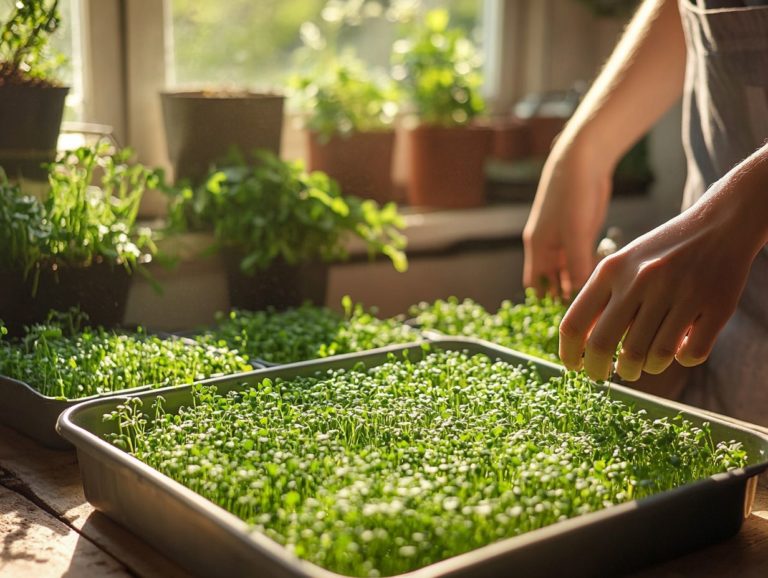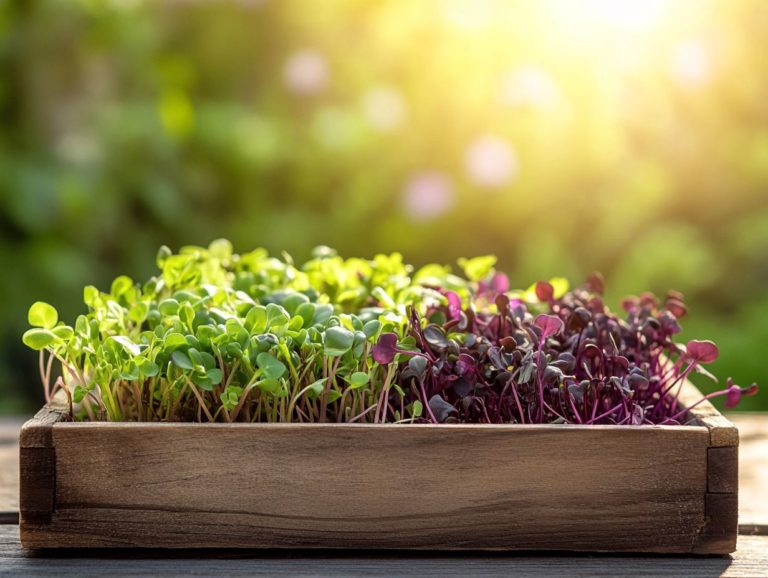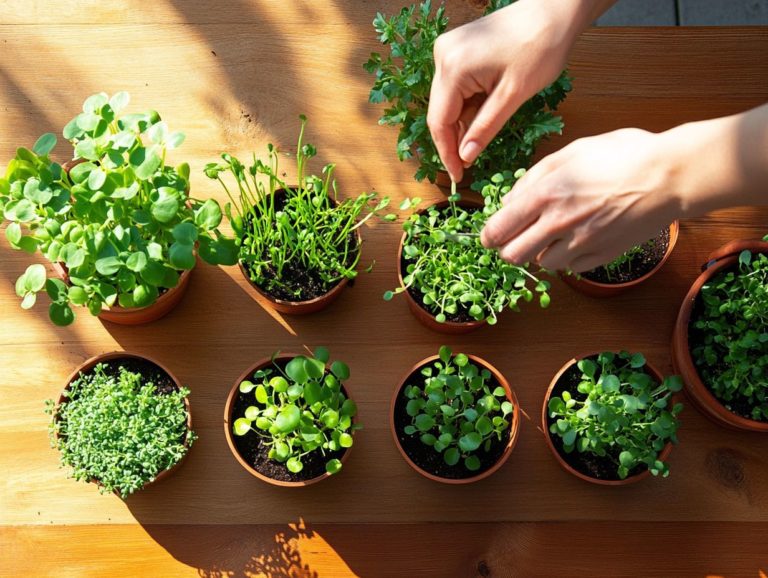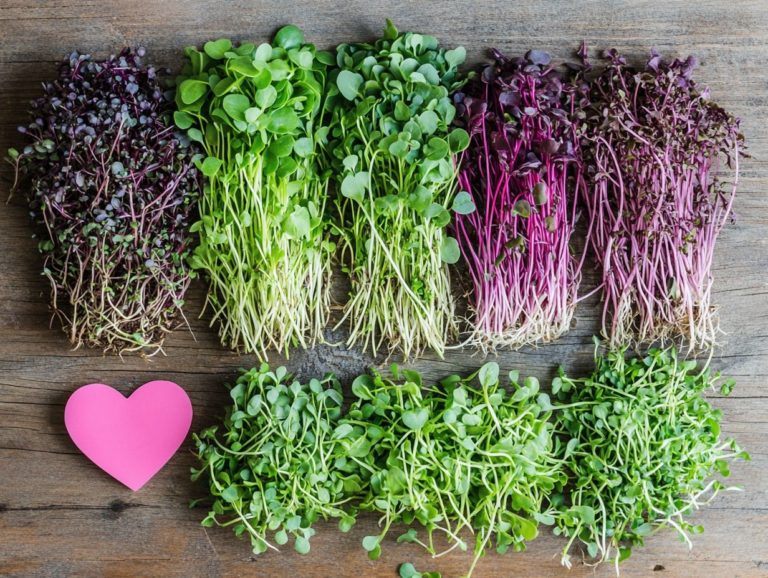Microgreens: Nature’s Vitamins in a Tiny Package
Microgreens aren t just a passing trend; they re a delightful explosion of flavor and nutrition packed into a tiny form.
This article delves into the world of microgreens, a powerful superfood, showcasing their distinctive traits and impressive nutritional advantages over their fully grown counterparts. You ll discover how integrating these vibrant greens into your diet can elevate both your health and culinary adventures.
We will also cover important food safety tips to ensure you savor these little wonders without a hitch.
Get ready to unleash the amazing benefits of microgreens today!
Contents
Key Takeaways:

- Microgreens are young, edible plants with intense flavors and concentrated nutrients.
- They pack a punch of vitamins and minerals, such as vitamins A, C, K, and E, with some varieties containing up to 40 times more nutrients than their mature counterparts.
- Including microgreens in your diet can improve nutrient intake and enhance flavor in meals, plus they can easily be grown at home.
What are Microgreens?
Microgreens are young, edible plants that you harvest just after the first leaves appear, typically within 7 to 21 days of germination. These petite greens are highly regarded for their vibrant flavors and remarkable nutrient density, making them a favorite among health food trends and establishing them as a potent superfood in health-conscious diets.
Varieties like sunflower microgreens, broccoli, cilantro, and kale not only elevate culinary creations but also play a vital role in community nourishment and health and wellness initiatives.
Definition and Characteristics
Microgreens are the young seedlings of edible vegetables and herbs that burst with nutrients and flavor. They often grace salads, sandwiches, and garnishes.
These vibrant greens reach their peak harvest stage within just 7 to 21 days after germination, displaying a delightful array of colors and textures that appeal to both chefs and home cooks alike. With their concentrated nutrient density, they deliver an impressive punch of vitamins and antioxidants, contributing to their high antioxidant capacity that elevates any dish. Discovering the benefits of eating microgreens daily highlights their remarkable flavor profiles, ranging from the peppery zest of arugula microgreens to the gentle sweetness of beet greens.
Common varieties like radish, basil, and cilantro not only brighten up a plate but also blend effortlessly into both raw and cooked culinary masterpieces, enhancing everything from soups to gourmet entrees.
Nutritional Value of Microgreens
Microgreens are nutritional powerhouses, offering a remarkable concentration of vitamins and minerals up to 40 times more than their mature counterparts. Incorporating them into your diet is essential for anyone focused on health and wellness.
Bursting with antioxidants and packed with vitamins such as A, C, K, and E, these tiny greens deliver concentrated nutrients that can significantly enhance your immunity and overall health.
Comparison to Mature Plants
When comparing microgreens to mature plants, it becomes clear that microgreens often offer superior nutrient density, delivering essential vitamins and antioxidants crucial for your health.
This impressive concentration of nutrients can be traced back to the fact that microgreens are harvested at a young, vibrant stage of growth, allowing them to pack a powerful punch of nutrients in a small package. For example, studies show that varieties like broccoli and radish microgreens are significantly richer in vitamins such as C, K, and E compared to their larger counterparts. This is why microgreens are superfoods you need.
These tiny greens also frequently boast elevated levels of antioxidants, which play a vital role in combating oxidative stress, or damage caused by free radicals, and inflammation. Such distinct advantages make microgreens, especially the best microgreens for nutritional value, an exceptional choice for anyone looking to enhance their diet with the maximum amount of vitamins and minerals.
Benefits of Incorporating Microgreens into Your Diet
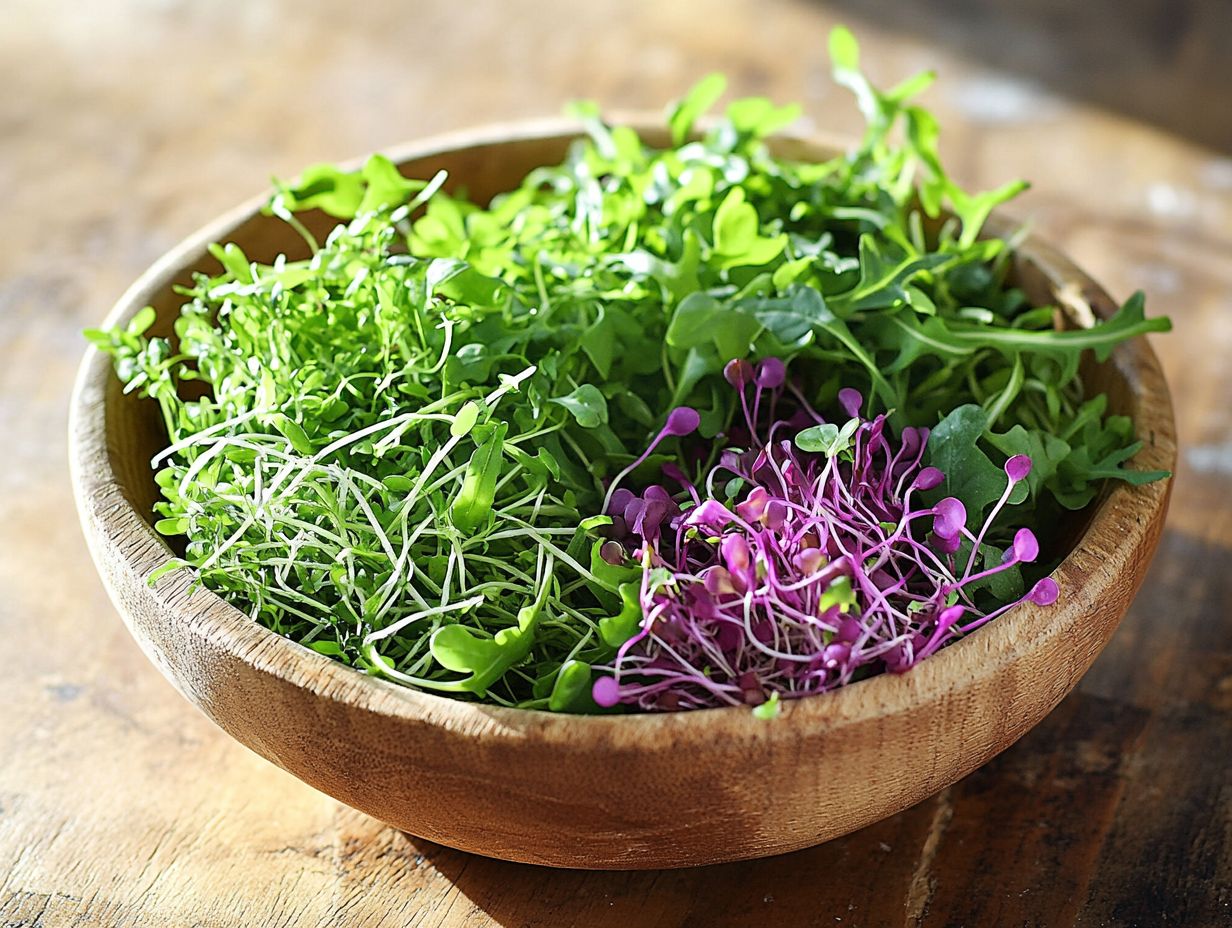
Incorporating microgreens into your diet presents a wealth of health benefits, including improved gut health that you won t want to overlook. They boost your nutrient intake, enhance flavors, and add a delightful dose of antioxidants to your meals.
These vibrant greens not only help fill missing nutrients but also elevate your culinary creations, providing simple yet effective solutions for health-conscious eating.
Improved Nutrient Intake
Microgreens can dramatically enhance your nutrient intake by providing a concentrated source of essential vitamins, minerals, and antioxidants vital for your overall health and wellness.
These tiny powerhouses are also extremely nutrient-dense, often delivering levels of vitamins A, C, E, and K that far exceed those found in their fully grown counterparts. Take broccoli microgreens, for instance; they are brimming with sulforaphane, a compound known for fighting cancer. And let’s not forget radish greens, which bring a zesty kick along with a generous dose of vitamin C. For more information, check out the health benefits of microgreens explained.
Incorporating these greens into your daily meals is a breeze. You can toss them into salads, blend them into smoothies, or use them as a vibrant garnish on soups and sandwiches. By adding microgreens to your diet, you effortlessly elevate your meals while ensuring you meet your essential nutritional needs. To learn more about their benefits, check out the science behind microgreens and health.
Enhanced Flavor and Texture
Microgreens are a game-changer in the kitchen! They elevate both flavor and texture in your culinary creations, making them a favored choice among chefs and home cooks alike. Their vibrant colors and distinctive flavors can transform an ordinary meal into something truly extraordinary, tantalizing not just your taste buds but also your visual senses.
With a wide array of varieties at your disposal, these petite greens offer unique flavor profiles from the peppery kick of arugula to the subtle sweetness of pea shoots and the refreshing allure of basil. By incorporating microgreens into your dishes, you can elevate everything from gourmet salads to exquisite main courses while also unlocking the antioxidant power of microgreens.
Picture avocado toast adorned with zesty radish microgreens or enhanced grain bowls topped with a sprinkle of spicy mustard greens. The delightful crunch they provide adds an intriguing textural element, beautifully complementing proteins like grilled chicken or fish.
It s clear that these tiny powerhouses bring a versatile charm to any culinary endeavor.
How to Grow Microgreens at Home
Cultivating microgreens at home is both an accessible and fulfilling pursuit, requiring little space and effort. It serves as an ideal gateway to the world of home gardening and sustainable practices, such as vertical and organic farming.
With straightforward methods, you can easily grow your own nutrient-rich greens right in your kitchen, transforming your culinary experience while embracing sustainability.
Step-by-Step Guide
To cultivate microgreens at home successfully, follow this comprehensive step-by-step guide, covering everything from seed selection to the delightful harvest of your greens.
- Begin by choosing a variety of seeds to introduce diverse flavors and nutrients to your garden. Popular choices include radish, mustard, and basil, each delivering its own unique taste and health benefits.
- Prepare the soil, ensuring it s nutrient-rich and well-draining. A high-quality potting mix creates the perfect environment for robust growth.
- After sowing the seeds, maintain consistent moisture. Lightly misting the soil daily will support optimal germination.
- When your microgreens reach about two inches in height, it s time to reap the rewards of your efforts. Using sharp scissors, snip them just above the soil line for the best results.
- Don t forget to provide ample light, whether through natural sunlight or grow lights, to enhance both growth and flavor.
Start growing your microgreens today and unlock a world of flavor and nutrition!
Ways to Enjoy Microgreens in Meals
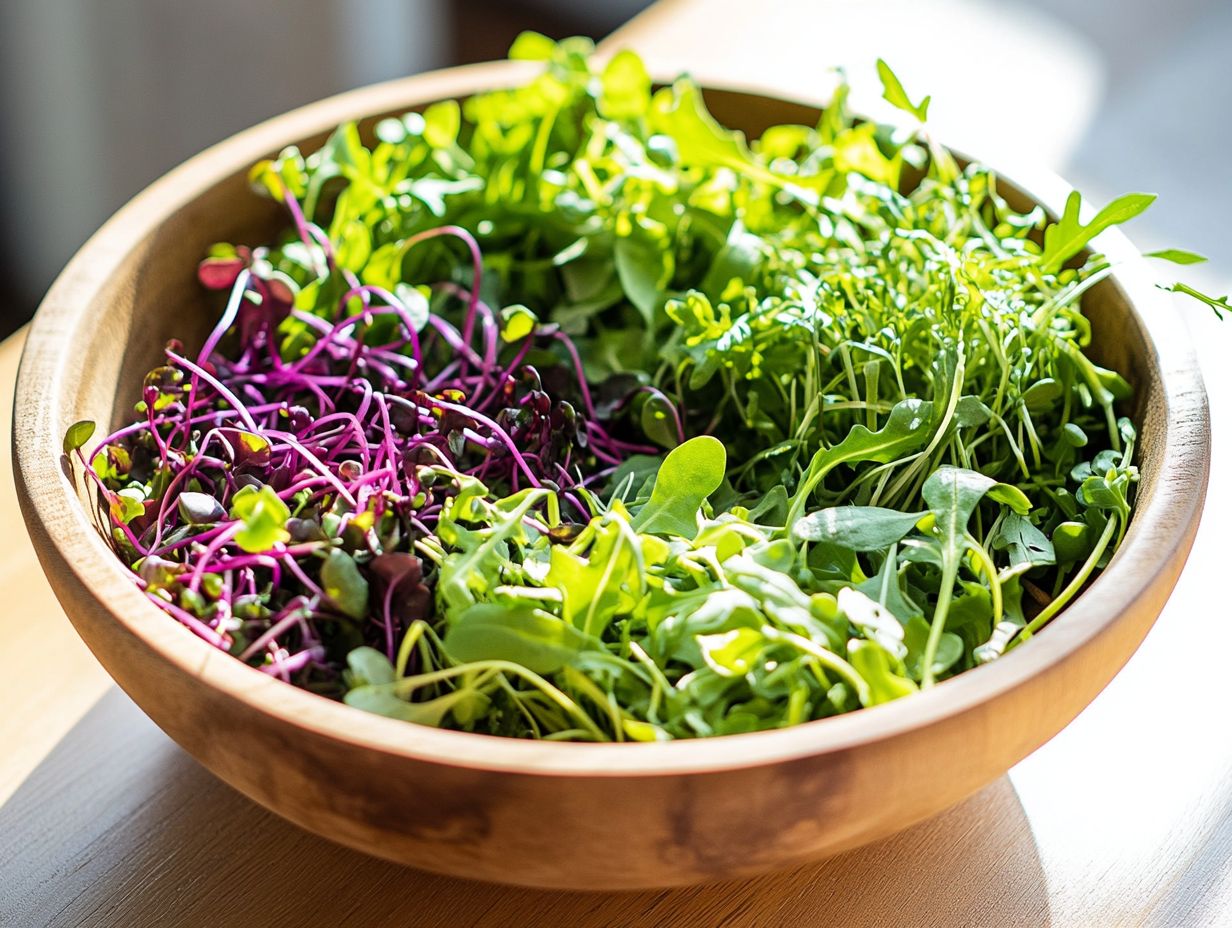
You have an abundance of options for incorporating microgreens into your meals. Whether you re enhancing salads and sandwiches or blending them into smoothies, they serve as a versatile and nutritious addition to any health-conscious diet.
Recipes and Ideas for Incorporating Microgreens
Incorporating microgreens into your meals opens up a world of creativity and nutrition. You can find numerous recipes that not only enhance flavor but also elevate health benefits.
These diminutive greens are brimming with vitamins and minerals. They serve as an excellent addition to salads, sandwiches, and even smoothies. Picture a vibrant arugula microgreen salad, beautifully adorned with cherry tomatoes and drizzled with a light vinaigrette. It delivers a fresh, peppery flavor that elevates any dish to new heights. Not only that, but microgreens are the secret to healthy skin, making them a fantastic choice for your overall well-being.
Mix pea shoots into a savory stir-fry for a delightful splash of color. They also provide essential nutrients that your body craves. Consider garnishing pasta or soups with basil microgreens; they enhance both the presentation and the taste, making every bite a little more special. Additionally, exploring the role of microgreens in healthy eating can further enrich your meals.
With their remarkable versatility, it s effortless to weave these healthful ingredients into your culinary creations. Ensure that each meal becomes a delicious step toward a healthier lifestyle.
Potential Risks and Precautions
While microgreens provide a wealth of health benefits, it s crucial to remain mindful of potential risks and necessary precautions. This includes being aware of food safety concerns and any allergies that may arise when incorporating them into your diet.
Food Safety and Allergies
Food safety takes center stage when you dive into the world of microgreens, especially since they can contain bacteria. Taking proper precautions is essential.
Start by meticulously washing the greens under running water to remove any dirt or contaminants that might be clinging to those delicate leaves. Once washed, it’s crucial to dry your microgreens thoroughly with clean paper towels or a salad spinner. For those interested in their health benefits, you can explore the nutritional benefits of common microgreens. Storing them in the refrigerator in a breathable container will help maintain their freshness while reducing the risk of spoilage.
Handling microgreens with clean hands and utensils is also key in preventing cross-contamination. Keep in mind that certain individuals might have allergies to specific microgreens, such as sunflower or pea shoots. Being aware of potential allergens is vital for a safe and enjoyable culinary experience, as microgreens are essential for a balanced diet.
Frequently Asked Questions
What are microgreens?
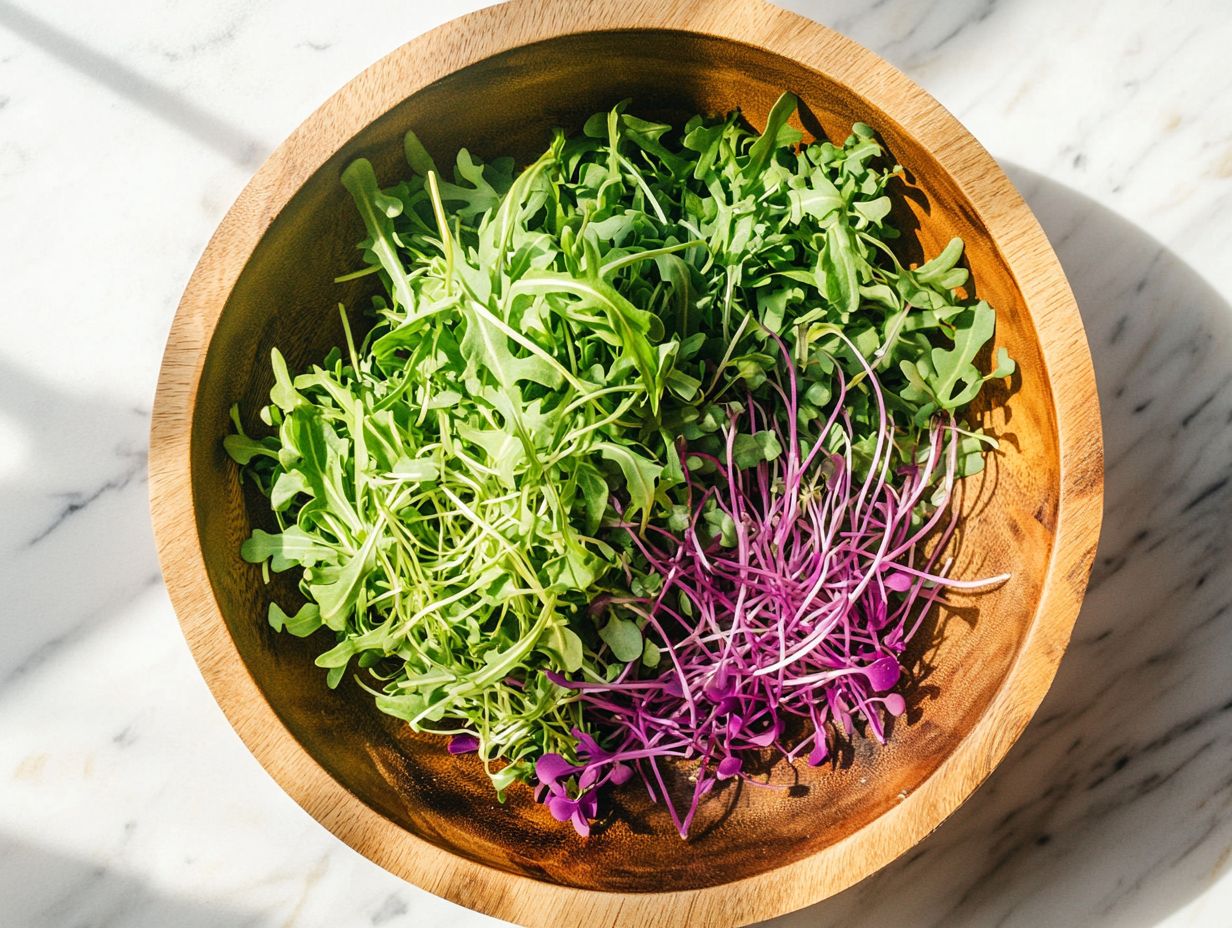
Microgreens are young vegetable greens that are harvested just a few weeks after sprouting. They are packed with nutrients and are smaller than baby greens, making them easy to add to a variety of dishes.
Why are microgreens considered nature’s vitamins?
Microgreens are often called nature’s vitamins because they contain a concentrated amount of nutrients, including vitamins, minerals, and antioxidants. They are considered a superfood due to their high nutrient content.
What types of microgreens are available?
There are many different types of microgreens available, including arugula, kale, broccoli, radish, and sunflower. Each type has its own unique flavor profile and nutrient composition.
How do I incorporate microgreens into my diet?
Microgreens can be added to salads, sandwiches, wraps, smoothies, and even used as a garnish for soups and main dishes. They can also be blended into dressings and sauces for an extra nutrient boost.
Are microgreens easy to grow at home?
Yes, microgreens are easy to grow at home and can be grown year-round. They can be grown in soil or in a hydroponic system a method of growing plants in water without soil making them a great option for those with limited space or outdoor gardening options.
What are the benefits of incorporating microgreens into my diet?
Incorporating microgreens into your diet can provide a wide range of health benefits, such as improved digestion, increased energy, and a strengthened immune system. They are also low in calories but high in nutrients, making them a great addition to any balanced diet.
Start adding microgreens to your plate and experience the difference in flavor and nutrition today!


